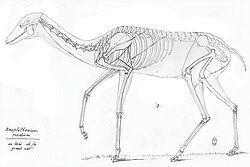Biology:Xiphodontidae
| Xiphodontidae | |
|---|---|

| |
| Drawing of Xiphodon by Georges Cuvier | |
| Scientific classification | |
| Domain: | Eukaryota |
| Kingdom: | Animalia |
| Phylum: | Chordata |
| Class: | Mammalia |
| Order: | Artiodactyla |
| Family: | †Xiphodontidae Flower, 1883 |
| Genera | |
|
†Dichodon | |
Xiphodontidae is an extinct family of herbivorous even-toed ungulates (order Artiodactyla), endemic to Europe during the Eocene 40.4—33.9 million years ago, existing for about 7.5 million years.[1] Paraxiphodon suggests that they survived into the Lower Oligocene, at least.[2]
Description
The molar teeth of xiphodontids are brachydont (low crowned) and selenodont.[3]
Taxonomy
The Xiphodontidae were named by Flower (1883). It was assigned to Artiodactyla by Cope (1889); to Xiphodontoidea by Hooker (1986); and to Tylopoda by Carroll (1988).[4][5] A 2020 study suggested them to be related to ruminants, as well as other Europe-endemic artiodactyls like Cainotheriidae and Anoplotheriidae.[6]
References
- ↑ PaleoBiology Database: Xiphodontidae, basic info
- ↑ Prothero, D.R.; Foss, S.E. (2007). The Evolution of Artiodactyls. Johns Hopkins University Press. ISBN 9780801887352. https://books.google.com/books?id=qO8H_alEofAC. Retrieved 2014-10-08.
- ↑ Blondel, C (April 2001). "The Eocene–Oligocene ungulates from Western Europe and their environment" (in en). Palaeogeography, Palaeoclimatology, Palaeoecology 168 (1–2): 125–139. doi:10.1016/S0031-0182(00)00252-2. https://linkinghub.elsevier.com/retrieve/pii/S0031018200002522.
- ↑ J. J. Hooker. 1986. Mammals from the Bartonian (middle/late Eocene) of the Hampshire Basin, southern England. Bulletin of the British Museum (Natural History) 39(4):191-478
- ↑ R. L. Carroll. 1988. Vertebrate Paleontology and Evolution. W. H. Freeman and Company, New York 1-698
- ↑ Luccisano, Vincent; Sudre, Jean; Lihoreau, Fabrice (2020-10-01). "Revision of the Eocene artiodactyls (Mammalia, Placentalia) from Aumelas and Saint-Martin-de-Londres (Montpellier limestones, Hérault, France) questions the early European artiodactyl radiation" (in en). Journal of Systematic Palaeontology 18 (19): 1631–1656. doi:10.1080/14772019.2020.1799253. ISSN 1477-2019. https://www.tandfonline.com/doi/full/10.1080/14772019.2020.1799253.
Wikidata ☰ Q2699941 entry
 |

